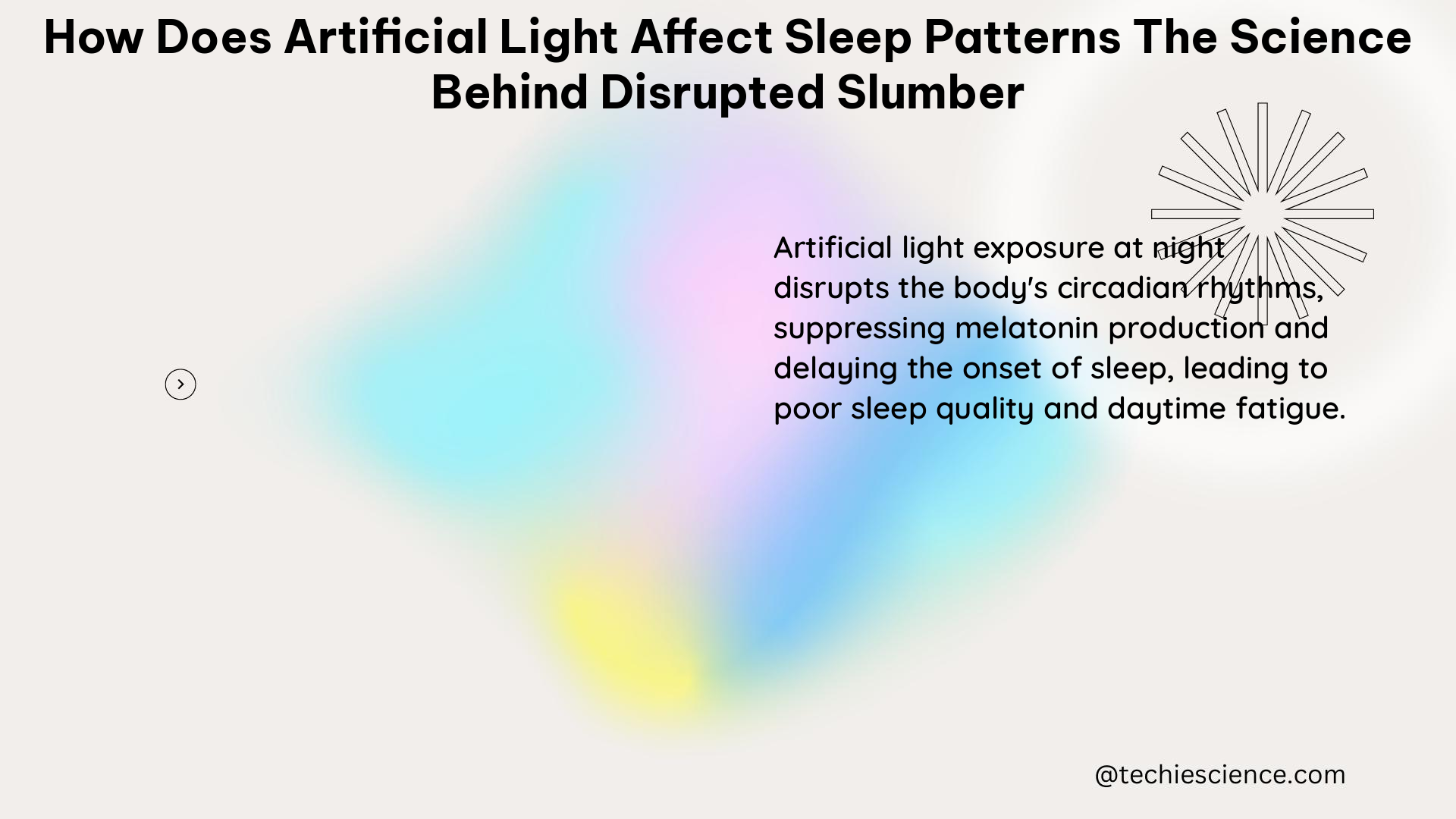Artificial light, particularly blue light emitted by electronic devices and energy-efficient light bulbs, can have a significant impact on sleep patterns and overall health. This comprehensive guide delves into the measurable and quantifiable data points that illustrate the science behind disrupted slumber.
Melatonin Suppression: The Hormone Regulator
Melatonin is a crucial hormone that regulates the body’s sleep-wake cycle. Exposure to blue light in the evening can suppress the production of this hormone, leading to disrupted sleep patterns.
- Melatonin Suppression Mechanism: Blue light, with a wavelength range of 450-500 nm, is particularly effective at suppressing melatonin production. This is because the retina in the human eye contains specialized photoreceptors called intrinsically photosensitive retinal ganglion cells (ipRGCs), which are most sensitive to this range of the light spectrum.
- Quantifiable Data: A study found that just two hours of exposure to blue light at night can suppress melatonin levels by up to 50%. This significant reduction in melatonin can have far-reaching consequences on the body’s natural sleep-wake cycle.
Circadian Rhythm Disruption: The Body’s Internal Clock

The body’s natural circadian rhythm, or internal clock, is responsible for regulating various physiological processes, including sleep-wake cycles. Artificial light can disrupt this delicate balance.
- Circadian Rhythm Mechanism: The circadian rhythm is primarily controlled by the suprachiasmatic nucleus (SCN) in the hypothalamus of the brain. The SCN acts as a master clock, synchronizing the body’s internal rhythms with the external 24-hour light-dark cycle.
- Quantifiable Data: A study found that exposure to room light before bedtime can phase-shift the circadian clock by 0.67 hours, while exposure to dim light can phase-shift it by 0.27 hours. This disruption in the circadian rhythm can lead to altered sleep patterns and other physiological changes.
Sleep Onset Latency: The Time to Fall Asleep
Artificial light can also impact the time it takes to fall asleep, known as sleep onset latency.
- Sleep Onset Latency Mechanism: Exposure to blue light, particularly from electronic devices, can suppress melatonin production and disrupt the body’s natural sleep-wake cycle. This can make it more difficult for the body to transition into a state of sleep.
- Quantifiable Data: A study found that reading a book from an e-reader for four hours before sleep increased sleep onset latency by 10 minutes. This delay in falling asleep can have a cascading effect on the overall quality and duration of sleep.
Sleep Efficiency: The Percentage of Time Spent Asleep
Artificial light can also decrease the efficiency of sleep, or the percentage of time spent asleep while in bed.
- Sleep Efficiency Mechanism: Exposure to light during sleep can disrupt the body’s natural sleep-wake cycle, leading to more frequent awakenings and a decrease in the overall time spent in a state of sleep.
- Quantifiable Data: A study found that exposure to room light during sleep can decrease sleep efficiency by 3%. This reduction in sleep efficiency can have negative impacts on the body’s ability to rest and recover.
Cardiovascular and Metabolic Health: The Broader Implications
The disruption of sleep patterns caused by artificial light exposure can also have broader implications for cardiovascular and metabolic health.
- Cardiovascular and Metabolic Health Mechanism: Exposure to artificial light during sleep can lead to increased insulin resistance and elevated heart rate throughout the night. This can have long-term consequences on the body’s ability to regulate blood sugar levels and maintain a healthy cardiovascular system.
- Quantifiable Data: A study found that a single night of moderate light exposure during sleep can increase insulin resistance and elevate heart rate throughout the night. This disruption in metabolic and cardiovascular function can contribute to the development of chronic health conditions.
Cancer Risk: The Potential Link
Disrupted circadian rhythms due to artificial light exposure have also been linked to an increased risk of certain types of cancer.
- Cancer Risk Mechanism: The disruption of the body’s natural sleep-wake cycle and melatonin production can have far-reaching effects on various physiological processes, including the regulation of cell growth and division. This can potentially contribute to the development of certain types of cancer.
- Quantifiable Data: Studies have found an association between disrupted circadian rhythms and an increased risk of breast and prostate cancer. While the exact mechanisms are still being investigated, the link between artificial light exposure and cancer risk is an area of ongoing research.
In conclusion, the science behind the impact of artificial light on sleep patterns is complex and multifaceted. By understanding the measurable and quantifiable data points, we can better appreciate the importance of limiting exposure to artificial light, particularly in the evening hours, to promote healthy sleep patterns and overall well-being.
References:
- Cajochen, C. (2007). Effects of light on human circadian rhythms, sleep and mood. Journal of Circadian Rhythms, 5(1), 2.
- Blue Light: What It Is and How It Affects Sleep. Sleep Foundation.
- I Can’t Sleep… Can you turn off the lights? Science in the News.
- Light & Sleep: Effects on Sleep Quality. Sleep Foundation.
- Sleeping with even a little light can be unhealthy, study finds. NPR.

The lambdageeks.com Core SME Team is a group of experienced subject matter experts from diverse scientific and technical fields including Physics, Chemistry, Technology,Electronics & Electrical Engineering, Automotive, Mechanical Engineering. Our team collaborates to create high-quality, well-researched articles on a wide range of science and technology topics for the lambdageeks.com website.
All Our Senior SME are having more than 7 Years of experience in the respective fields . They are either Working Industry Professionals or assocaited With different Universities. Refer Our Authors Page to get to know About our Core SMEs.